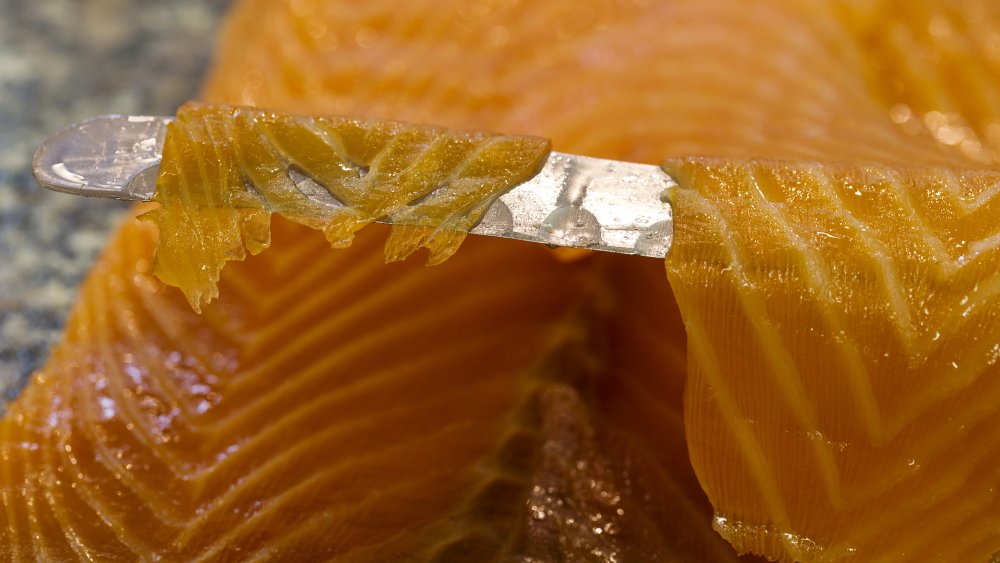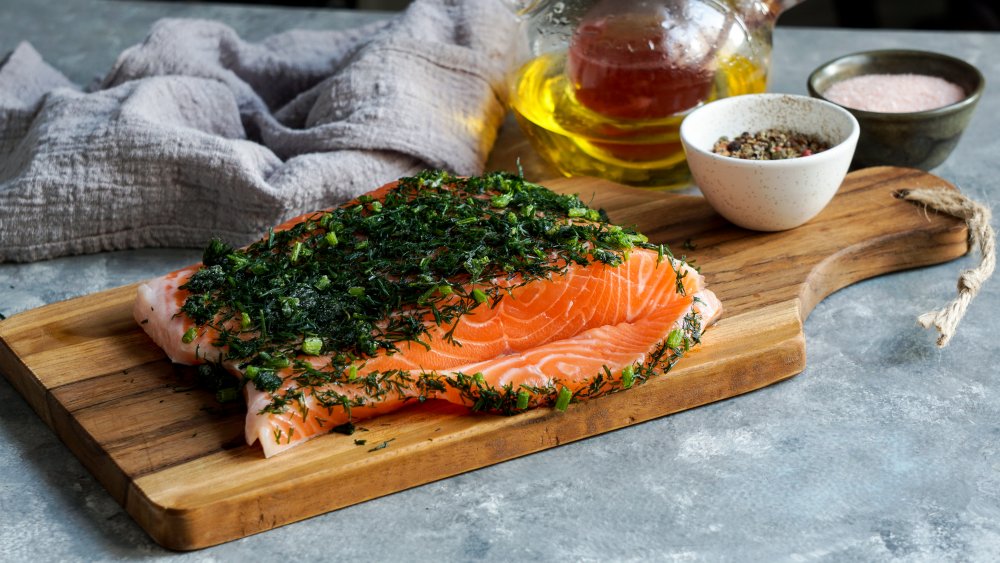What's The Difference Between Smoked Salmon And Lox?
A bagel with cream cheese may not be the most nutritious breakfast, but it is delicious. There are many possible toppings, too, including tomato and smoked salmon. However, some of them can be confusing, and really, what is the difference between smoked salmon and lox?
The first thing to know is that smoked salmon is a more overarching term used to describe multiple different ways of preparing salmon. There is lox, Nova lox, Gravlax, cold-smoked, and hot-smoked salmon (via HuffPost).
The differences begin with the process, starting with whether the fish is smoked or cured. Curing is the process in which a food is preserved with salt, as well as potentially other flavors or aromatics. Smoking is a process in which food is exposed to smoke.
The smoking process is then broken down again, as there are two methods of smoking fish — cold-smoked and hot-smoked. Cold-smoked refers to salmon being smoked at a temperature below 85 degrees, and hot-smoked refers to anything above that. When you're talking about salmon that tops bagels, you're usually talking about cold-smoked (via Bon Appetit).
Cold-smoked salmon is usually brined with salt and sugar, which is used to help the salt penetrate the fish. It is then smoked for 10 to 15 hours. The salmon gets smoked through a process that involves the burning wood being in one location and the salmon in another, and then the smoke is blown over the salmon during the long smoking period.
Types of smoked salmon
With cold-smoked salmon, there are again multiple types: Nova, Scottish salmon, Norwegian salmon, Irish salmon, and Western Nova.
Nova refers to salmon from Nova Scotia, though the term has also come to mean smoked salmon that is cured and then smoked. This is the type of smoked salmon most people are used to eating. Scottish salmon is smoked, but is a fatty fish that retains a lot of moisture. Western Nova is made using wild king salmon and is a leaner and more muscular fish that has a tighter texture and a stronger flavor than most of the others (via Eater). The Norwegian salmon has a lighter smoky taste and a milder flavor. Irish salmon is fattier and also has a milder smoky taste, but has a texture similar to Nova.
The owner of Russ and Daughters, a hugely popular New York City bagel place, described the differences (via Eater): "Cold-smoked salmon is the stuff that can be sliced so thin you can read the [New York] Times through it. Cured salmon has a similar texture, but without any smoke flavor. Hot-smoked salmon has a completely different texture — meaty and flaky, like cooked salmon."
The process of preparing lox
Lox, which is short for belly lox, is salmon that has been cured in salt, and was how people ate the fish before refrigeration was common. It has a very strong taste and is very salty. Authentic lox is made from the belly of the salmon, hence the name "belly lox," and is cured in salt for approximately three months (via Epicurious). When people order lox, they are usually referring to Nova smoked salmon, not actual lox.
Much like with smoked salmon, there are multiple types of lox. The Scandinavian preparation of lox is called Gravlax. For this, the fish is cured but not smoked. A combination of dill, lemon, and alcohol, and frequently vodka, are used in the curing process. It was originally buried, so in the modern process, it is common to put weight on it, such as under a heavy iron pan. The weight helps the spices and herbs penetrate the fish during the curing process, drawing out the moisture and infusing the flavors, which lasts for at least two days.
The differences between some of these are subtle. If you want to try one, ask the person making your bagel for a recommendation based on your taste. If you want to stick with what you already eat, now you understand the specifics of the smoking process more clearly and know if you are eating lox or Nova smoked salmon.


